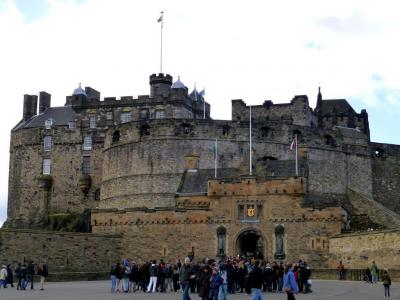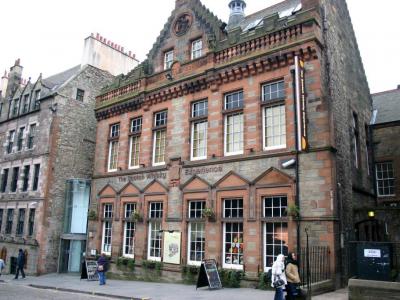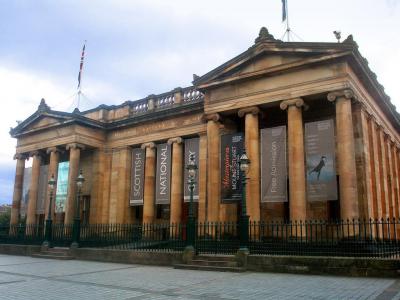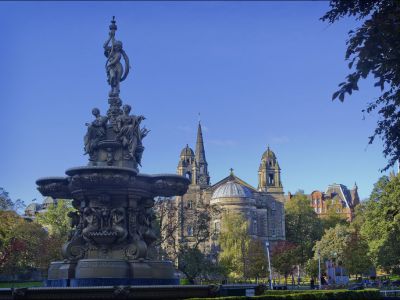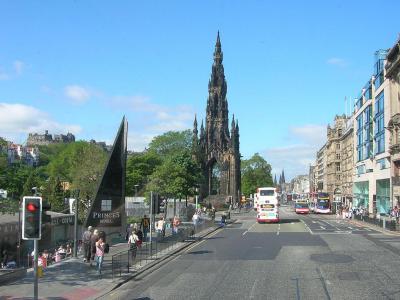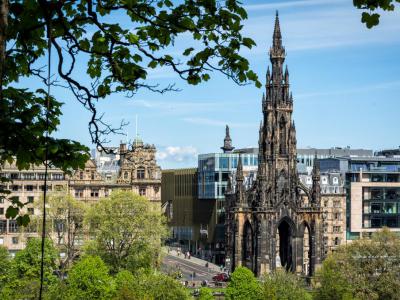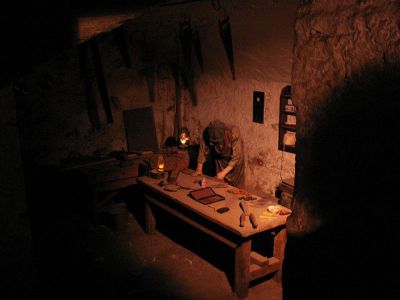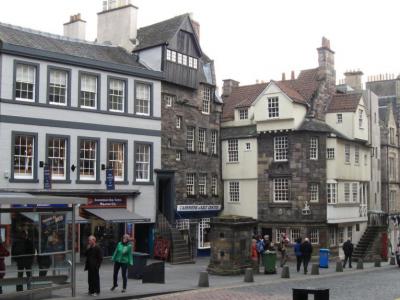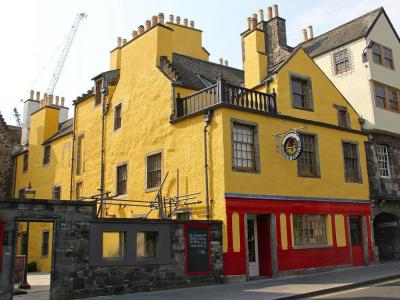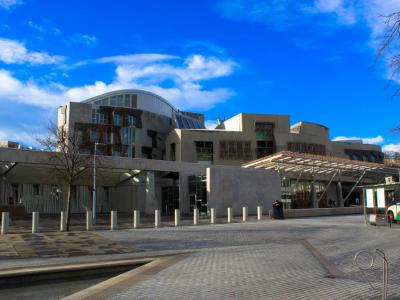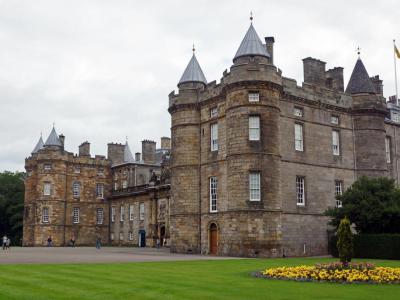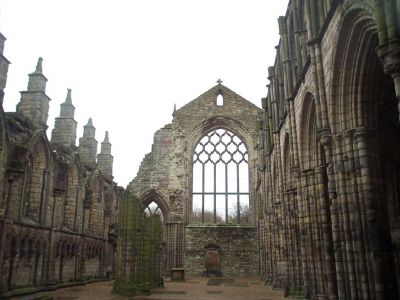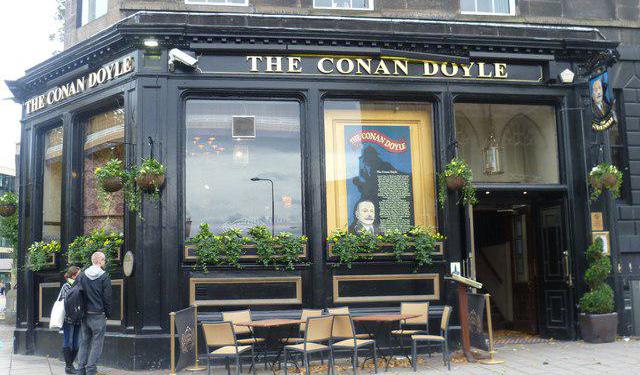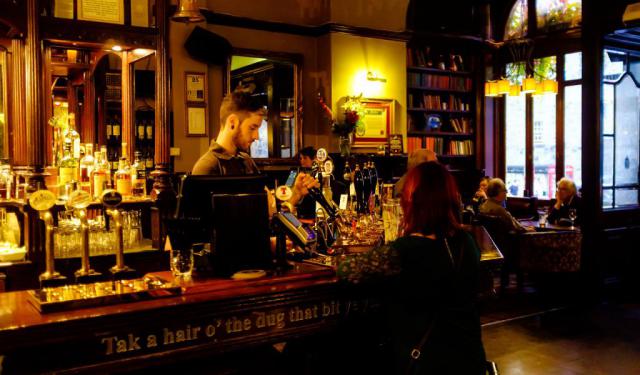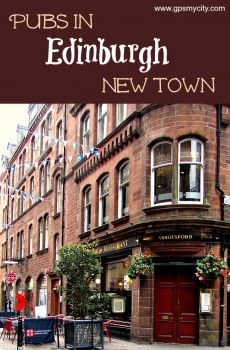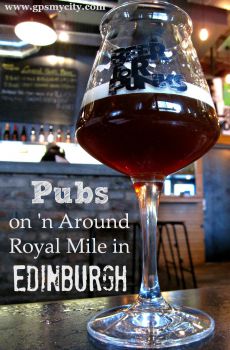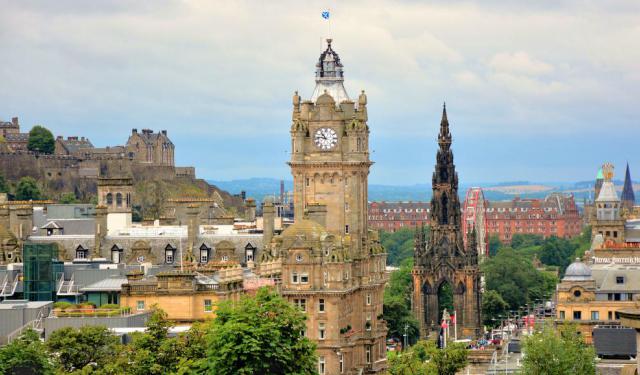
Edinburgh Introduction Walking Tour (Self Guided), Edinburgh
Comfortably yet tightly packed on the hilly terrain, Edinburgh – the Scottish capital since at least the 15th century, and the seat of the Scottish Parliament since 1999 – is a picturesque city renowned for its unique architecture of the medieval Old Town and elegant Georgian New Town, currently both listed as a UNESCO World Heritage site. The earliest known human habitation in the area dates back to c. 8500 BC. King David I established the royal burgh on the site in the early 12th century, which by the 15th century had been described as "the principal burgh of [the Scottish] kingdom".
By the first half of the 18th century, Edinburgh was one of Europe's most densely populated, overcrowded and unsanitary towns. In the second half of the century, it was at the heart of the Scottish Enlightenment, with thinkers like Adam Smith being familiar faces in the street. As a major intellectual centre, the city even earned the nickname "Athens of the North".
Amid the relatively little, compared to other cities in Britain, industrialisation in the 19th century, the central part of Edinburgh, between Princes Street and George Street, became a major commercial and shopping district. Improvements carried out in the 1860s began the transformation of the area into the predominantly Victorian Old Town seen today. More improvements followed in the early 20th century, but relative economic stagnation during the two world wars and beyond saw the Old Town deteriorate further before major slum clearance in the 1960s and 1970s began to reverse the process.
A new "financial district" grown since the 1990s enabled Edinburgh to maintain its place as the UK's second largest financial and administrative centre, after London. The city is also home to a number of national institutions, such as the Scottish National Gallery, plus a wealth of historical and cultural attractions which make it the country's second most visited tourist destination, attracting annually more than 4 million visitors, including over 2 million from overseas.
Historic sites of Edinburgh include, among others, Edinburgh Castle – once the seat of the Scottish royals and now home to the country's crown jewels – dominating the cityscape, the Palace of Holyroodhouse – the official residence of the monarch in Scotland, the churches of St. Giles, and more. To explore these and other prominent sights of the Scottish capital, follow this self-guided walk!
By the first half of the 18th century, Edinburgh was one of Europe's most densely populated, overcrowded and unsanitary towns. In the second half of the century, it was at the heart of the Scottish Enlightenment, with thinkers like Adam Smith being familiar faces in the street. As a major intellectual centre, the city even earned the nickname "Athens of the North".
Amid the relatively little, compared to other cities in Britain, industrialisation in the 19th century, the central part of Edinburgh, between Princes Street and George Street, became a major commercial and shopping district. Improvements carried out in the 1860s began the transformation of the area into the predominantly Victorian Old Town seen today. More improvements followed in the early 20th century, but relative economic stagnation during the two world wars and beyond saw the Old Town deteriorate further before major slum clearance in the 1960s and 1970s began to reverse the process.
A new "financial district" grown since the 1990s enabled Edinburgh to maintain its place as the UK's second largest financial and administrative centre, after London. The city is also home to a number of national institutions, such as the Scottish National Gallery, plus a wealth of historical and cultural attractions which make it the country's second most visited tourist destination, attracting annually more than 4 million visitors, including over 2 million from overseas.
Historic sites of Edinburgh include, among others, Edinburgh Castle – once the seat of the Scottish royals and now home to the country's crown jewels – dominating the cityscape, the Palace of Holyroodhouse – the official residence of the monarch in Scotland, the churches of St. Giles, and more. To explore these and other prominent sights of the Scottish capital, follow this self-guided walk!
How it works: Download the app "GPSmyCity: Walks in 1K+ Cities" from Apple App Store or Google Play Store to your mobile phone or tablet. The app turns your mobile device into a personal tour guide and its built-in GPS navigation functions guide you from one tour stop to next. The app works offline, so no data plan is needed when traveling abroad.
Edinburgh Introduction Walking Tour Map
Guide Name: Edinburgh Introduction Walking Tour
Guide Location: Scotland » Edinburgh (See other walking tours in Edinburgh)
Guide Type: Self-guided Walking Tour (Sightseeing)
# of Attractions: 14
Tour Duration: 2 Hour(s)
Travel Distance: 3.4 Km or 2.1 Miles
Author: alexei
Sight(s) Featured in This Guide:
Guide Location: Scotland » Edinburgh (See other walking tours in Edinburgh)
Guide Type: Self-guided Walking Tour (Sightseeing)
# of Attractions: 14
Tour Duration: 2 Hour(s)
Travel Distance: 3.4 Km or 2.1 Miles
Author: alexei
Sight(s) Featured in This Guide:
- Edinburgh Castle
- Scotch Whisky Experience
- Camera Obscura and World of Illusions
- Scottish National Gallery
- Princes Street Gardens
- Princes Street
- Scott Monument
- St. Giles' Cathedral
- Mary King's Close
- John Knox House
- Museum of Edinburgh
- Scottish Parliament Building
- Holyroodhouse
- Holyrood Abbey
1) Edinburgh Castle (must see)
Edinburgh Castle, presiding over Edinburgh since the 12th century, is the second most visited attraction in the United Kingdom, after the Tower of London. The history of Scotland is deeply etched into its ancient stones.
The castle stands on top of the Castle Rock, the basalt ventilation pipe of an extinct volcano eroded by glaciers. People have inhabited this area since the 9th century BC. The first castle on the site was constructed by King David I of Scotland, and had remained a royal residence until 1603.
As a fortress, it was virtually impregnable, except for one major drawback: the basalt rock on which it stood didn't hold water, so a 28-meter well quickly dried out during droughts or long sieges, leaving the denizens either to surrender or die of thirst.
The first castle was largely destroyed during the Lang Siege in 1573; the only remainder from that 12th century structure still standing is Saint Margaret’s Chapel. In the 17th century it became a military base, with the garrison quartered there until the 1920s.
Presently, the castle houses the Scottish National War Memorial, the National War Museum of Scotland and several smaller regimental museums. It is also home to the One O’Clock Gun, which is fired six days a week at precisely 1 PM, and the city’s clocks are set by it.
In the Crown Room, you will see the Royal Scottish Crown, Scepter and Sword of State, with actors in period costume re-enacting important events of the castle’s history. In August, the Edinburgh Military Tattoo takes place on the castle’s esplanade. In the north-east corner of the esplanade is a small iron fountain, called the Witches’ Well. It marks the spot where, in the past, many women were burned at the stake for witchcraft.
Why You Should Visit:
The views from the castle are some of the best in Scotland, and the walk up visiting all the little places herein makes it a really good experience.
Tip:
The entry is cheaper if you book online, and more importantly, it allows to avoid the often long line.
Take a free guided tour – available every hour. Otherwise, consider audio guide at £3, quite useful.
Being at the top of the mountain, it may get windy, so definitely bring layers if visiting in cold weather.
The castle stands on top of the Castle Rock, the basalt ventilation pipe of an extinct volcano eroded by glaciers. People have inhabited this area since the 9th century BC. The first castle on the site was constructed by King David I of Scotland, and had remained a royal residence until 1603.
As a fortress, it was virtually impregnable, except for one major drawback: the basalt rock on which it stood didn't hold water, so a 28-meter well quickly dried out during droughts or long sieges, leaving the denizens either to surrender or die of thirst.
The first castle was largely destroyed during the Lang Siege in 1573; the only remainder from that 12th century structure still standing is Saint Margaret’s Chapel. In the 17th century it became a military base, with the garrison quartered there until the 1920s.
Presently, the castle houses the Scottish National War Memorial, the National War Museum of Scotland and several smaller regimental museums. It is also home to the One O’Clock Gun, which is fired six days a week at precisely 1 PM, and the city’s clocks are set by it.
In the Crown Room, you will see the Royal Scottish Crown, Scepter and Sword of State, with actors in period costume re-enacting important events of the castle’s history. In August, the Edinburgh Military Tattoo takes place on the castle’s esplanade. In the north-east corner of the esplanade is a small iron fountain, called the Witches’ Well. It marks the spot where, in the past, many women were burned at the stake for witchcraft.
Why You Should Visit:
The views from the castle are some of the best in Scotland, and the walk up visiting all the little places herein makes it a really good experience.
Tip:
The entry is cheaper if you book online, and more importantly, it allows to avoid the often long line.
Take a free guided tour – available every hour. Otherwise, consider audio guide at £3, quite useful.
Being at the top of the mountain, it may get windy, so definitely bring layers if visiting in cold weather.
2) Scotch Whisky Experience (must see)
What's the difference between “whisky” and “whiskey”? If you don’t know, visit The Scotch Whisky Experience to find the answer and discover a whole lot of other interesting facts about Scotland’s favourite tipple.
This interactive museum is great fun, even for children, who have their own guide – “Peat the Cat”, that will take them on an exciting tour full of fascinating facts and games. For adults, the journey through the museum begins with a barrel ride taking them through a mechanical replica of one of the first whisky distilleries. In there, the “Whisky Ghost” will tell you all about the distilling process.
Leaving the distillery, you’ll enter the MacIntyre Whisky Gallery where you will learn some, but not all the secrets about how the different whisky flavours are attained. Certain procedures are kept secret to keep the competition guessing! From this gallery, you’ll continue into the Sense of Scotland and experience the heady aromas of various types of whisky.
Finally, you’ll visit the tasting room where you will certainly find a whisky to suit your taste buds – just don’t ask for ice or soda, as these additives are almost hanging offenses! The museum has a wonderful shop with over 300 different malts on offer and gift boxes of miniatures.
The shop is open to the museum visitors and general public alike, but if you have taken the tour, you will have a generous discount on your purchases.
Why You Should Visit:
To feast your eyes on the largest collection of unopened whiskies with around 3400 different bottles valued at millions of pounds. To learn some history and tasting tips, plus to get to try whisky on its own, as well as with the artisan Scottish cheese and chocolate.
Tip:
If you go on a tour, sign up for “gold” option if you like to sample whisky to your heart's content; otherwise, sign up for "silver", which is for those not keen on whisky that much but still wanting to learn about the distilling process.
This interactive museum is great fun, even for children, who have their own guide – “Peat the Cat”, that will take them on an exciting tour full of fascinating facts and games. For adults, the journey through the museum begins with a barrel ride taking them through a mechanical replica of one of the first whisky distilleries. In there, the “Whisky Ghost” will tell you all about the distilling process.
Leaving the distillery, you’ll enter the MacIntyre Whisky Gallery where you will learn some, but not all the secrets about how the different whisky flavours are attained. Certain procedures are kept secret to keep the competition guessing! From this gallery, you’ll continue into the Sense of Scotland and experience the heady aromas of various types of whisky.
Finally, you’ll visit the tasting room where you will certainly find a whisky to suit your taste buds – just don’t ask for ice or soda, as these additives are almost hanging offenses! The museum has a wonderful shop with over 300 different malts on offer and gift boxes of miniatures.
The shop is open to the museum visitors and general public alike, but if you have taken the tour, you will have a generous discount on your purchases.
Why You Should Visit:
To feast your eyes on the largest collection of unopened whiskies with around 3400 different bottles valued at millions of pounds. To learn some history and tasting tips, plus to get to try whisky on its own, as well as with the artisan Scottish cheese and chocolate.
Tip:
If you go on a tour, sign up for “gold” option if you like to sample whisky to your heart's content; otherwise, sign up for "silver", which is for those not keen on whisky that much but still wanting to learn about the distilling process.
3) Camera Obscura and World of Illusions (must see)
Established in 1835 by entrepreneur Maria Theresa Short, Camera Obscura & World of Illusions holds historical significance in the development of regional planning, particularly in the context of Patrick Geddes' work. This unique attraction features more than 100 interactive exhibits, including the original Camera Obscura, spread across five floors, including a rooftop terrace offering panoramic views of Edinburgh.
Initially, Maria Theresa Short's "Short's Popular Observatory" was located in a wooden and stone building near the National Monument on Calton Hill. However, in 1851, this observatory was dismantled by authorities. Subsequently, Short relocated to Castlehill and, in 1852, purchased the townhouse of the Laird of Cockpen. She expanded the building by adding two additional storeys, creating Short's Observatory, Museum of Science and Art, which operated from 1853 to 1892.
In 1892, the site came under the management of Patrick Geddes, a pioneering Scottish urban planner, sociologist, and ecologist. He renamed it the "Outlook Tower" and transformed it into a museum and urban study center, reflecting his planning philosophy based on comprehensive surveys of the site, city, and region. The tower featured exhibits on various geographic themes as one ascended, ranging from the world on the ground floor to Europe, English-speaking countries, Scotland, and finally Edinburgh, with the camera obscura located in the topmost room.
The museum ceased operations following Geddes' passing in 1932. In 1966, the University of Edinburgh acquired the site with the intention of establishing the Patrick Geddes Centre and archive. In 1982, the building changed ownership to a private individual, but a one-room Geddes exhibit remained on the fourth floor.
Today, the tower stands as the city's oldest attraction, inviting visitors to explore six floors of interactive exhibits, including a top-floor Camera Obscura providing a virtual city tour. The rooftop terrace offers breathtaking views of Edinburgh with telescopes, while the lower floors house the "World of Illusions" featuring optical illusions, light, color, puzzles, a mirror maze, and a vortex tunnel. Besides its tourist appeal, the tower serves as an educational hub, delving into optical illusions, holography, photography origins, and Edinburgh's history.
Initially, Maria Theresa Short's "Short's Popular Observatory" was located in a wooden and stone building near the National Monument on Calton Hill. However, in 1851, this observatory was dismantled by authorities. Subsequently, Short relocated to Castlehill and, in 1852, purchased the townhouse of the Laird of Cockpen. She expanded the building by adding two additional storeys, creating Short's Observatory, Museum of Science and Art, which operated from 1853 to 1892.
In 1892, the site came under the management of Patrick Geddes, a pioneering Scottish urban planner, sociologist, and ecologist. He renamed it the "Outlook Tower" and transformed it into a museum and urban study center, reflecting his planning philosophy based on comprehensive surveys of the site, city, and region. The tower featured exhibits on various geographic themes as one ascended, ranging from the world on the ground floor to Europe, English-speaking countries, Scotland, and finally Edinburgh, with the camera obscura located in the topmost room.
The museum ceased operations following Geddes' passing in 1932. In 1966, the University of Edinburgh acquired the site with the intention of establishing the Patrick Geddes Centre and archive. In 1982, the building changed ownership to a private individual, but a one-room Geddes exhibit remained on the fourth floor.
Today, the tower stands as the city's oldest attraction, inviting visitors to explore six floors of interactive exhibits, including a top-floor Camera Obscura providing a virtual city tour. The rooftop terrace offers breathtaking views of Edinburgh with telescopes, while the lower floors house the "World of Illusions" featuring optical illusions, light, color, puzzles, a mirror maze, and a vortex tunnel. Besides its tourist appeal, the tower serves as an educational hub, delving into optical illusions, holography, photography origins, and Edinburgh's history.
4) Scottish National Gallery (must see)
No art lover should miss a chance to visit the Scottish National Gallery, which is found on the Mound, just next to the Royal Scottish Academy. When opened in 1859, the gallery shared the place with the academy. It also housed the Portrait Gallery, and the lack of space became a real problem until the Portrait Gallery moved to its new location. But by 1906 more space had been needed, and so the academy moved into the building next door.
The gallery was entirely renovated in 1912. Today it features both Scottish and European art and boasts the collection of over 30,000 paintings, prints, drawings and sculpture dating from the early Renaissance period to the late 19th century. Among them are works by Bassano, Bernini, Botticelli, Cézanne, Constable and Degas, paintings and drawings by El Greco, Titian, Tiepolo, and da Vinci. Lovers of Gauguin will admire “Vision of the Sermon”, whilst those keen on sculpture will surely appreciate “The Three Graces” by Canova.
The gallery also houses an amazing Research Library, featuring over 50,000 books, journals, microfilms and slides, dating from the 1300s through the 1900s, being one of the finest reference libraries in the world.
The Western Link is an underground interconnection between the gallery and the academy. In this area, there is a lecture theatre, a restaurant, and the gallery shop. There is also an interactive IT Gallery where, using touch-screens, you can observe the gallery’s entire collection.
Why You Should Visit:
Good selection of great Scottish and non-Scottish works; an intimate and cozy way to spend a few hours.
Entry is free for permanent exhibitions; a small fee for special collections.
Tip:
Make sure you go into both the main Gallery building and the Academy building behind it.
Note that the wonderful Turner watercolor exhibition goes on show every January – truly some wonderful insights into his travels around Europe.
The gallery was entirely renovated in 1912. Today it features both Scottish and European art and boasts the collection of over 30,000 paintings, prints, drawings and sculpture dating from the early Renaissance period to the late 19th century. Among them are works by Bassano, Bernini, Botticelli, Cézanne, Constable and Degas, paintings and drawings by El Greco, Titian, Tiepolo, and da Vinci. Lovers of Gauguin will admire “Vision of the Sermon”, whilst those keen on sculpture will surely appreciate “The Three Graces” by Canova.
The gallery also houses an amazing Research Library, featuring over 50,000 books, journals, microfilms and slides, dating from the 1300s through the 1900s, being one of the finest reference libraries in the world.
The Western Link is an underground interconnection between the gallery and the academy. In this area, there is a lecture theatre, a restaurant, and the gallery shop. There is also an interactive IT Gallery where, using touch-screens, you can observe the gallery’s entire collection.
Why You Should Visit:
Good selection of great Scottish and non-Scottish works; an intimate and cozy way to spend a few hours.
Entry is free for permanent exhibitions; a small fee for special collections.
Tip:
Make sure you go into both the main Gallery building and the Academy building behind it.
Note that the wonderful Turner watercolor exhibition goes on show every January – truly some wonderful insights into his travels around Europe.
5) Princes Street Gardens (must see)
Between Edinburgh Castle and Princes Street, renowned for its superb shops, pubs and restaurants, lies the beautiful Princes Street Gardens, a haven of peace and beauty in the heart of the city.
A 110,000 years ago the area that is now the gardens was formed by glacial erosion, when the basalt bulk of Castle Rock caused a glacier to divide around it, forming a depression at the foot of the rock. For thousands of years the area had been marshland, and when people came to the region, it formed a natural defence at the foot of Castle Rock; it has been inhabited since the 9th century BC.
King James III ordered the marsh to be flooded in 1460 to add to the defences of the Old Town and Edinburgh Castle. The flooded area was named Nor Loch and dominated the area until it was drained in 1759; although the vicinity sometimes gets flooded even today.
When the New Town was under construction, millions of tons of earth were dumped in the former loch and this eventually became The Mound, upon which many prestigious buildings stand today. The gardens were created in 1820; on the east side of The Mound they cover an area of 8.5 acres and on the west side they take up 29 acres.
The most important monument in the gardens is the Scott Monument, and there are a lot of statues dedicated to John Wilson, David Livingstone, and Allan Ramsey, among others. There is a play area for children, lush lawns and spreading trees, lots of benches, kiosks and a café.
In the weeks leading up to Christmas and into the New Year, the park hosts fairground rides, the city’s main Christmas Market and an ice-skating rink.
A 110,000 years ago the area that is now the gardens was formed by glacial erosion, when the basalt bulk of Castle Rock caused a glacier to divide around it, forming a depression at the foot of the rock. For thousands of years the area had been marshland, and when people came to the region, it formed a natural defence at the foot of Castle Rock; it has been inhabited since the 9th century BC.
King James III ordered the marsh to be flooded in 1460 to add to the defences of the Old Town and Edinburgh Castle. The flooded area was named Nor Loch and dominated the area until it was drained in 1759; although the vicinity sometimes gets flooded even today.
When the New Town was under construction, millions of tons of earth were dumped in the former loch and this eventually became The Mound, upon which many prestigious buildings stand today. The gardens were created in 1820; on the east side of The Mound they cover an area of 8.5 acres and on the west side they take up 29 acres.
The most important monument in the gardens is the Scott Monument, and there are a lot of statues dedicated to John Wilson, David Livingstone, and Allan Ramsey, among others. There is a play area for children, lush lawns and spreading trees, lots of benches, kiosks and a café.
In the weeks leading up to Christmas and into the New Year, the park hosts fairground rides, the city’s main Christmas Market and an ice-skating rink.
6) Princes Street
Running from Leith Street to the Lothian Road in the New Town, Princes Street is an over a mile long stretch of shops, cafés and pubs, and is, in fact, the most important thoroughfare in Edinburgh.
The street was named after two of King George III’s sons: Prince George (who later became King George V) and Prince Frederick. The early 18th century buildings here were renovated first in the 19th century and then in the 1960s, under the “Princes Street Plan”, seeing some of them pulled down and replaced with “pro-forma” pattern constructions to enlarge storefronts.
Most of the shops are on the north side of the street, the south side looks out over the valley towards the Old Town and Edinburgh Castle. Most of the valley is taken up by Princes Street Gardens, which were created in 1820 when Nor Loch was drained.
The gardens comprise 38 acres separated by the Mound, and are a favourite tourist venue. Amid the numerous statues and monuments found here, the most important one is the War Memorial erected for Scottish-American soldiers.
In the summer, open-air theatre performances and concerts are held on the Ross Bandstand. There is also a beautiful floral clock to admire.
The street was named after two of King George III’s sons: Prince George (who later became King George V) and Prince Frederick. The early 18th century buildings here were renovated first in the 19th century and then in the 1960s, under the “Princes Street Plan”, seeing some of them pulled down and replaced with “pro-forma” pattern constructions to enlarge storefronts.
Most of the shops are on the north side of the street, the south side looks out over the valley towards the Old Town and Edinburgh Castle. Most of the valley is taken up by Princes Street Gardens, which were created in 1820 when Nor Loch was drained.
The gardens comprise 38 acres separated by the Mound, and are a favourite tourist venue. Amid the numerous statues and monuments found here, the most important one is the War Memorial erected for Scottish-American soldiers.
In the summer, open-air theatre performances and concerts are held on the Ross Bandstand. There is also a beautiful floral clock to admire.
7) Scott Monument (must see)
Sir Walter Scott was perhaps Scotland’s best-loved poet and novelist, so it is only natural that the nation wanted to pay homage to him, and they surely did so with the Scott Monument in Princes Gardens.
Upon Scott's death in 1832, an architectural competition was launched to build a monument in his honour. A great many noted architects submitted their ideas; the winning design was by George Meikle Kemp, a draughtsman who had no architectural experience and had submitted his design under the name of John Morvo, a 15th-century stonemason and architect.
The 61-metre high monument has several viewing galleries accessed by narrow winding stairways. The highest gallery is reachable by climbing 287 stairs, so if/when you get to the top, you are given a certificate proving that you have indeed survived the climb!
The monument was built out of Binny Sandstone, a substance so oily that it attracts dirt very fast, so that a year after the construction was finished, it looked as if it had been there for centuries. The American author, Bill Bryson described it as a “Gothic rocket-ship”.
The lovely marble statue of Sir Walter, seated with his writing implements and his faithful dog at his feet, was sculpted by John Steell. The 64 statues decorating the monument feature characters from Sir Walter’s books. You will also see many grotesques – those hideous character faces so beloved by Gothic architects, which Kemp included in his design to add to the monument’s “ancient” appearance.
Why You Should Visit:
To enjoy the monument casually at its base, or to climb up for a 360-degree panorama view (note a fee attached to that).
Tip:
It might be good to know – especially if you are claustrophobic – that this gets a little tight, especially if other climbers happen to be going in the opposite direction.
Upon Scott's death in 1832, an architectural competition was launched to build a monument in his honour. A great many noted architects submitted their ideas; the winning design was by George Meikle Kemp, a draughtsman who had no architectural experience and had submitted his design under the name of John Morvo, a 15th-century stonemason and architect.
The 61-metre high monument has several viewing galleries accessed by narrow winding stairways. The highest gallery is reachable by climbing 287 stairs, so if/when you get to the top, you are given a certificate proving that you have indeed survived the climb!
The monument was built out of Binny Sandstone, a substance so oily that it attracts dirt very fast, so that a year after the construction was finished, it looked as if it had been there for centuries. The American author, Bill Bryson described it as a “Gothic rocket-ship”.
The lovely marble statue of Sir Walter, seated with his writing implements and his faithful dog at his feet, was sculpted by John Steell. The 64 statues decorating the monument feature characters from Sir Walter’s books. You will also see many grotesques – those hideous character faces so beloved by Gothic architects, which Kemp included in his design to add to the monument’s “ancient” appearance.
Why You Should Visit:
To enjoy the monument casually at its base, or to climb up for a 360-degree panorama view (note a fee attached to that).
Tip:
It might be good to know – especially if you are claustrophobic – that this gets a little tight, especially if other climbers happen to be going in the opposite direction.
8) St. Giles' Cathedral (must see)
Saint Giles’ Cathedral, otherwise known as the High Kirk of Edinburgh, on the Royal Mile is the one you definitely wouldn't want to miss. The first church on this site, put up in the 12th century, was destroyed by fire; only the central pillars remain. The second church, built in 1385, over a period of time had many chapels added, giving it a rather haphazard appearance. At one time, the church boasted over 50 side altars, called aisles.
In 1466, the cathedral became a collegiate church, to which the lantern tower, in the form of a crown, was added in 1490. During the Reformation in 1560, most of the church’s treasures were removed, stolen or sold, including the most precious relic – Saint Giles’ withered arm and hand which had a diamond ring on one skeletal finger. The church itself was separated into numerous preaching halls by partition walls during that period.
Although called a cathedral, it was only one for two short periods of time during the Bishop Wars in the 17th century, so its statute of High Kirk is more important. It was restored in the 19th century, the partitions were removed and several chapels pulled down. The most beautiful of all the remaining ones is the Thistle Chapel, built in 1911 in a 15th-century High Gothic style. The wood and stone carvings are marvelous; it is filled with heraldry banners and has a breath-taking delicately carved vault.
Among the memorials here are a bronze relief plaque, dedicated to Robert Louis Stevenson, in the Moray Aisle; a marble sculpture of James Graham, the 1st Marquis of Montrose, in the Chapman Aisle; and another dedicated to Archibald Campbell, the 1st Marquis of Argyll, in the Saint Eloi Aisle. These two men, deadly enemies at the end of their lives, were the main signatories of the National Covenant in 1638.
Why You Should Visit:
Quiet, architecturally very special, and with such a wealth of spectacular stained glass that one cannot be anything else but awed.
Tip:
Entry is free or by donation, but if you want to take pics, you'll need to fork over £2 for a "permit".
Best to get onto a tour as there's much you could miss just wandering on your own. A rooftop tour (£6) is also worth it.
Don't miss the café downstairs. The food is great and it is really cute.
In 1466, the cathedral became a collegiate church, to which the lantern tower, in the form of a crown, was added in 1490. During the Reformation in 1560, most of the church’s treasures were removed, stolen or sold, including the most precious relic – Saint Giles’ withered arm and hand which had a diamond ring on one skeletal finger. The church itself was separated into numerous preaching halls by partition walls during that period.
Although called a cathedral, it was only one for two short periods of time during the Bishop Wars in the 17th century, so its statute of High Kirk is more important. It was restored in the 19th century, the partitions were removed and several chapels pulled down. The most beautiful of all the remaining ones is the Thistle Chapel, built in 1911 in a 15th-century High Gothic style. The wood and stone carvings are marvelous; it is filled with heraldry banners and has a breath-taking delicately carved vault.
Among the memorials here are a bronze relief plaque, dedicated to Robert Louis Stevenson, in the Moray Aisle; a marble sculpture of James Graham, the 1st Marquis of Montrose, in the Chapman Aisle; and another dedicated to Archibald Campbell, the 1st Marquis of Argyll, in the Saint Eloi Aisle. These two men, deadly enemies at the end of their lives, were the main signatories of the National Covenant in 1638.
Why You Should Visit:
Quiet, architecturally very special, and with such a wealth of spectacular stained glass that one cannot be anything else but awed.
Tip:
Entry is free or by donation, but if you want to take pics, you'll need to fork over £2 for a "permit".
Best to get onto a tour as there's much you could miss just wandering on your own. A rooftop tour (£6) is also worth it.
Don't miss the café downstairs. The food is great and it is really cute.
9) Mary King's Close (must see)
If you are a fan of ghost stories and haunted houses, you’ll love Real Mary King’s Close, which is reputed to be one of the most haunted places in Edinburgh, found deep under the Royal Exchange building.
The close is a series of winding streets and tenement houses that were used as the foundations of the Royal Exchange, many years after they had been closed off during the Great Plague that struck the city in 1645.
The plague, which came from Europe, was carried here by the fleas on the merchant ships’ rats and infested the poorer parts of the city, where hygiene was minimal, to say the least. Carried by flea bites, the plague spread and many of the poorer tenement areas were closed off as urgent quarantine measures.
Mary King’s Close was one such area and, according to legend, the people left inside the streets and buildings were bricked in and left to die either of the plague or starvation. Their ghosts, and particularly one of a small girl, named Annie, are said to be haunting the place.
The area was uncovered during renovations to the building over it and was opened to the public in 2003 as a tourist attraction. Guides in costume dress will lead you through the underground streets, which have been restored to 17th-century designs, and tell you the history of Mary King, the master seamstress, after whom the close was named, as well as about Annie.
You can leave a toy or make a small donation to the poor little spirit who wanders the streets looking for her favourite doll. All these gifts are, in turn, given to the hospital for sick children and other charities.
The close is a series of winding streets and tenement houses that were used as the foundations of the Royal Exchange, many years after they had been closed off during the Great Plague that struck the city in 1645.
The plague, which came from Europe, was carried here by the fleas on the merchant ships’ rats and infested the poorer parts of the city, where hygiene was minimal, to say the least. Carried by flea bites, the plague spread and many of the poorer tenement areas were closed off as urgent quarantine measures.
Mary King’s Close was one such area and, according to legend, the people left inside the streets and buildings were bricked in and left to die either of the plague or starvation. Their ghosts, and particularly one of a small girl, named Annie, are said to be haunting the place.
The area was uncovered during renovations to the building over it and was opened to the public in 2003 as a tourist attraction. Guides in costume dress will lead you through the underground streets, which have been restored to 17th-century designs, and tell you the history of Mary King, the master seamstress, after whom the close was named, as well as about Annie.
You can leave a toy or make a small donation to the poor little spirit who wanders the streets looking for her favourite doll. All these gifts are, in turn, given to the hospital for sick children and other charities.
10) John Knox House
House museums are always interesting to visit, not only because you get a fascinating insight into the lives of the building’s former occupants, but also because you can see what things were in fashion back in the day. John Knox House is no exception.
Built around 1490, this is the oldest house on the Royal Mile. It has wonderful hand-painted ceilings, oak beams and wooden galleries. Today it is owned and managed by the Church of Scotland, but previously it belonged to James Mossman, who was a royal goldsmith. He fashioned the crown for Mary, Queen of Scots, and later, the crown for her son, King James VI of Scotland.
Whether John Knox, the 16th century Protestant Reformer, actually ever lived here is debatable, but the house, which had become badly dilapidated, was saved from demolition in the 18th century by the Society of Antiquaries of Scotland, who put about the rumour that this had been Knox’s home before he died.
The house museum is a great place to visit for anyone who is interested in religious history as there are many manuscripts and artefacts from the Reformation period, including papers placed in a time capsule by Knox.
The museum is part of the Scottish Story-Telling Centre, and the history of Knox, Mossman and life in Edinburgh before and after the Reformation are related by guides in dress costume. There is a special room for children, full of puzzles, where they can dress up as John Knox.
Built around 1490, this is the oldest house on the Royal Mile. It has wonderful hand-painted ceilings, oak beams and wooden galleries. Today it is owned and managed by the Church of Scotland, but previously it belonged to James Mossman, who was a royal goldsmith. He fashioned the crown for Mary, Queen of Scots, and later, the crown for her son, King James VI of Scotland.
Whether John Knox, the 16th century Protestant Reformer, actually ever lived here is debatable, but the house, which had become badly dilapidated, was saved from demolition in the 18th century by the Society of Antiquaries of Scotland, who put about the rumour that this had been Knox’s home before he died.
The house museum is a great place to visit for anyone who is interested in religious history as there are many manuscripts and artefacts from the Reformation period, including papers placed in a time capsule by Knox.
The museum is part of the Scottish Story-Telling Centre, and the history of Knox, Mossman and life in Edinburgh before and after the Reformation are related by guides in dress costume. There is a special room for children, full of puzzles, where they can dress up as John Knox.
11) Museum of Edinburgh
A visit to the Museum of Edinburgh, set in the 16th century Huntley House on The Royal Mile, is the one not to be missed, for sure. Housed in the former Guild of Hammermen building, this wonderful museum is all about the origins, history and legends of the city.
In addition to the many fine silverware objects displayed here, there is also a collection of beautiful glassware engraved in nearby Canongate, fine Scottish pottery, magnificent grandfather clocks and a Sedan chair. The interactive area, apart from hosting workshops and quizzes, allows visitors to dress up in period costumes representing fashion of different epochs. Each item within the museum is clearly labeled with a short description about its history and origins.
Among these, you can see relics from a 1st century Roman settlement unearthed during excavations in Cramond, a small village to the north-west of Edinburgh, where the River Almond empties into the Firth of Forth.
You will also find the original copy of the National Covenant, James Craig’s designs for the New Town and Greyfriars Bobby’s dog dish and collar. There is a “rogues’ gallery” of sorts, where you will meet Deacon Brodie, who was a cabinet maker by day and a house-breaker by night, or Burke and Hare, the infamous body-snatchers who sold their gruesome merchandise to Dr Robert Knox of the University of Medicine.
In addition to the many fine silverware objects displayed here, there is also a collection of beautiful glassware engraved in nearby Canongate, fine Scottish pottery, magnificent grandfather clocks and a Sedan chair. The interactive area, apart from hosting workshops and quizzes, allows visitors to dress up in period costumes representing fashion of different epochs. Each item within the museum is clearly labeled with a short description about its history and origins.
Among these, you can see relics from a 1st century Roman settlement unearthed during excavations in Cramond, a small village to the north-west of Edinburgh, where the River Almond empties into the Firth of Forth.
You will also find the original copy of the National Covenant, James Craig’s designs for the New Town and Greyfriars Bobby’s dog dish and collar. There is a “rogues’ gallery” of sorts, where you will meet Deacon Brodie, who was a cabinet maker by day and a house-breaker by night, or Burke and Hare, the infamous body-snatchers who sold their gruesome merchandise to Dr Robert Knox of the University of Medicine.
12) Scottish Parliament Building
The Scottish Parliament Building, located at Holyrood in Edinburgh, is a notable feature within the UNESCO World Heritage Site in the city's center. This building has been a subject of debate since its inception, facing criticism over its location, architectural design, and construction decisions from politicians, the media, and Scottish citizens. Construction began in June 1999, with an initial plan to open in 2001, but it officially opened much later, on October 9, 2004, with a ceremony led by Queen Elizabeth II.
The Parliament complex, spanning 1.6 hectares at the base of Arthur’s Seat on Holyrood Road, was designed by the late Spanish architect Enric Miralles. He aimed to blend the Scottish environment, culture, and the essence of Edinburgh in the design, using features like leaf-shaped skylights in the Garden Lobby and large windows offering views of Holyrood Park. The building predominantly uses Scottish materials like local stone and oak for walls and floors, along with sycamore furnishings.
Public opinion about the Parliament Building is divided; it's a structure you either admire or dislike. A visit, preferably through a guided tour which allows access to otherwise restricted areas, is recommended to form your own opinion. The surrounding gardens, which are open to the public, feature an array of wildflowers, shrubs, trees, a water pool, lawns, and pathways.
Despite mixed reactions from the public and initial criticisms, the Parliament Building has been acknowledged positively in architectural circles, winning several accolades including the 2005 Stirling Prize. Landscape architect Charles Jencks lauded it as an outstanding example of quality and craftsmanship in British architecture over the past century.
The Parliament complex, spanning 1.6 hectares at the base of Arthur’s Seat on Holyrood Road, was designed by the late Spanish architect Enric Miralles. He aimed to blend the Scottish environment, culture, and the essence of Edinburgh in the design, using features like leaf-shaped skylights in the Garden Lobby and large windows offering views of Holyrood Park. The building predominantly uses Scottish materials like local stone and oak for walls and floors, along with sycamore furnishings.
Public opinion about the Parliament Building is divided; it's a structure you either admire or dislike. A visit, preferably through a guided tour which allows access to otherwise restricted areas, is recommended to form your own opinion. The surrounding gardens, which are open to the public, feature an array of wildflowers, shrubs, trees, a water pool, lawns, and pathways.
Despite mixed reactions from the public and initial criticisms, the Parliament Building has been acknowledged positively in architectural circles, winning several accolades including the 2005 Stirling Prize. Landscape architect Charles Jencks lauded it as an outstanding example of quality and craftsmanship in British architecture over the past century.
13) Holyroodhouse (must see)
A “must-see” location on many’s list visiting Edinburgh, Holyroodhouse on the Royal Mile is an important part of Scotland’s history. It is the official residence of the United Kingdom’s monarchs and was once the home of Mary, Queen of Scots.
King David I founded the abbey in 1128 and in 1501 the palace was built next to it. Today, only a small part of the original gatehouse remains. A “palace” was a rather grandiose title for what was a large house, but it was enlarged in 1532 and 1536. The property was renovated in 1633, but during Cromwell’s time it was used as barracks for his soldiers and was badly damaged during a fire.
In the 1670s, it was rebuilt by Sir William Bruce, and the abbey chapel became the Chapel Royal which was then used until 1768 when the roof fell in. The chapel and the house were restored again in 1822 and once more during the reign of King George V and Queen Mary. They also had indoor bathrooms and loos put in.
The house is open to the public when the “Royals” aren't in residence; you can admire the delicate stucco-work on the ceilings in the Royal Apartments and look your fill at the portraits of Scotland’s kings, both real and legendary, painted by Jacob de Wet.
The highlight of the visit is the Royal Collection which consists of armor, books, ceramics, clocks, drawings, jewelry, manuscripts, maps, paintings, prints, sculpture, silverware and weapons collected by kings and queens over a period of 500 years and held in trust for the nation by the Crown.
If you are lucky, you might catch a glimpse of the ghost of Agnes Sampson who has haunted the house since 1592 when she was tortured and put to death for witchcraft.
King David I founded the abbey in 1128 and in 1501 the palace was built next to it. Today, only a small part of the original gatehouse remains. A “palace” was a rather grandiose title for what was a large house, but it was enlarged in 1532 and 1536. The property was renovated in 1633, but during Cromwell’s time it was used as barracks for his soldiers and was badly damaged during a fire.
In the 1670s, it was rebuilt by Sir William Bruce, and the abbey chapel became the Chapel Royal which was then used until 1768 when the roof fell in. The chapel and the house were restored again in 1822 and once more during the reign of King George V and Queen Mary. They also had indoor bathrooms and loos put in.
The house is open to the public when the “Royals” aren't in residence; you can admire the delicate stucco-work on the ceilings in the Royal Apartments and look your fill at the portraits of Scotland’s kings, both real and legendary, painted by Jacob de Wet.
The highlight of the visit is the Royal Collection which consists of armor, books, ceramics, clocks, drawings, jewelry, manuscripts, maps, paintings, prints, sculpture, silverware and weapons collected by kings and queens over a period of 500 years and held in trust for the nation by the Crown.
If you are lucky, you might catch a glimpse of the ghost of Agnes Sampson who has haunted the house since 1592 when she was tortured and put to death for witchcraft.
14) Holyrood Abbey
Holyrood Abbey, established in 1128 by King David I, is a historical site in ruins. The term "Holyrood" derives from an old Scottish term for the cross where Jesus Christ was crucified, translating to "Holy Cross." The founding of the abbey is tied to a legend involving King David I, who, during a hunting expedition near Edinburgh in 1127, had a near-fatal encounter with a hart. It's said that either a miraculous cross appeared or sunlight reflecting off a crucifix in the hart's antlers saved him. In appreciation, the king founded the abbey at this location.
The structure of the original abbey church underwent significant changes between 1195 and 1230. Throughout history, it served various roles, including hosting the Scottish Parliament and acting as a royal residence. Notably, the Treaty of Edinburgh-Northampton, marking the end of the First War of Scottish Independence, was signed here in 1328.
The abbey's architecture was altered in 1633 for Charles I's coronation. However, it suffered damage and neglect after 1688, when a mob desecrated it following the Glorious Revolution. This neglect and subsequent structural changes led to the collapse of the roof in 1768, leaving it in its current state as a roofless ruin.
Despite proposals for restoration, the abbey remains unrestored. It is adjacent to the Palace of Holyroodhouse, near Edinburgh's Royal Mile, and is part of the Holyrood Park. This park, with its varied landscape including Arthur's Seat, offers panoramic views of Edinburgh and is a popular spot for outdoor activities like biking and hiking.
The structure of the original abbey church underwent significant changes between 1195 and 1230. Throughout history, it served various roles, including hosting the Scottish Parliament and acting as a royal residence. Notably, the Treaty of Edinburgh-Northampton, marking the end of the First War of Scottish Independence, was signed here in 1328.
The abbey's architecture was altered in 1633 for Charles I's coronation. However, it suffered damage and neglect after 1688, when a mob desecrated it following the Glorious Revolution. This neglect and subsequent structural changes led to the collapse of the roof in 1768, leaving it in its current state as a roofless ruin.
Despite proposals for restoration, the abbey remains unrestored. It is adjacent to the Palace of Holyroodhouse, near Edinburgh's Royal Mile, and is part of the Holyrood Park. This park, with its varied landscape including Arthur's Seat, offers panoramic views of Edinburgh and is a popular spot for outdoor activities like biking and hiking.
Walking Tours in Edinburgh, Scotland
Create Your Own Walk in Edinburgh
Creating your own self-guided walk in Edinburgh is easy and fun. Choose the city attractions that you want to see and a walk route map will be created just for you. You can even set your hotel as the start point of the walk.
New Town Walking Tour
Rightly regarded as the historic masterpiece of city planning, the New Town of Edinburgh has been a UNESCO World Heritage Site since 1995. The area forms a significant part of the Scottish capital and is known for its elegant Georgian architecture, abundant shopping opportunities, and many other delights firmly associated with this city.
One of the prominent landmarks in the New Town is... view more
Tour Duration: 2 Hour(s)
Travel Distance: 2.5 Km or 1.6 Miles
One of the prominent landmarks in the New Town is... view more
Tour Duration: 2 Hour(s)
Travel Distance: 2.5 Km or 1.6 Miles
Literary Landmarks Tour
For centuries, Edinburgh has been home to numerous writers. The likes of Robert Burns, Robert Louis Stevenson, and JK Rowling, just to name a few, have given pride to this city. Fortunately, the tradition doesn't seem to die out any time soon, as Edinburgh keeps producing more and more authors and literary heroes in whose footsteps people still wish to tread.
Naturally, there is a wealth... view more
Tour Duration: 1 Hour(s)
Travel Distance: 2.9 Km or 1.8 Miles
Naturally, there is a wealth... view more
Tour Duration: 1 Hour(s)
Travel Distance: 2.9 Km or 1.8 Miles
Famous Squares and Streets Walking Tour
Being in Edinburgh, it is only natural to be curious about the avenues, boulevards, and streets leading to (or stemming from) the city's picturesque squares. There, you can find a copious amount of historic and religious sites, fashion stores, classy restaurants, and marketplaces, not to mention some hidden gems, exploring which is well worth the time spent.
One of Edinburgh's most... view more
Tour Duration: 2 Hour(s)
Travel Distance: 2.9 Km or 1.8 Miles
One of Edinburgh's most... view more
Tour Duration: 2 Hour(s)
Travel Distance: 2.9 Km or 1.8 Miles
Edinburgh Pub Crawl
Edinburgh is rich in pubs, both old and new, spoiling their patrons with the best in town drinks and food. Although most traditional pubs in the city are laid back, with a quiet and relaxing atmosphere, some have dance floors and double as nightclubs. This self-guided adventure takes you to several such spots, each with its own story to tell.
Our journey begins at the World's End Pub, a... view more
Tour Duration: 1 Hour(s)
Travel Distance: 1.5 Km or 0.9 Miles
Our journey begins at the World's End Pub, a... view more
Tour Duration: 1 Hour(s)
Travel Distance: 1.5 Km or 0.9 Miles
Harry Potter Trail
Years after the release of the last Harry Potter book and movie, the cultural phenomenon of Harry Potter doesn't seem to fade away and the fandom continues strong as ever. Although by now Harry Potter has become a household name across the globe, the fact that J.K. Rowling penned some of the world's favorite wizarding stories in Scotland's capital, where she still lives now, makes... view more
Tour Duration: 2 Hour(s)
Travel Distance: 2.6 Km or 1.6 Miles
Tour Duration: 2 Hour(s)
Travel Distance: 2.6 Km or 1.6 Miles
Royal Mile Walking Tour
The Royal Mile, a steep thoroughfare in the heart of Edinburgh's Old Town, is one of the city's busiest tourist destinations. It runs down a slope, from the famed Edinburgh Castle to Holyroodhouse Palace and the ruined Holyrood Abbey, for almost exactly a mile and thus got its name, coined in 1920. The succession of streets forming the Royal Mile is lined with numerous shops, pubs,... view more
Tour Duration: 2 Hour(s)
Travel Distance: 1.6 Km or 1 Miles
Tour Duration: 2 Hour(s)
Travel Distance: 1.6 Km or 1 Miles
Useful Travel Guides for Planning Your Trip
19 Best Pubs in New Town, Edinburgh
A guide to the pubs that make up the area that is called Edinburgh's New Town. A description about what you can expect from each of the locations in the directory. A fantastic directory if you are a tourist or even a...
Scottish Souvenirs: 15 Authentic Scottish Things to Buy in Edinburgh
The popularity of Scotland stretches far beyond its geographical borders, fueled, in large part, by Hollywood's interest in the Scottish theme - Sean Connery (as James Bond), "Braveheart", etc. Indeed, the cultural spectrum of this part of Britain is enormous and comprises great...
Top 12 Pubs On and Around Royal Mile in Edinburgh
Edinburgh is a vibrant city with abundant nightlife and no shortage of places to go after dusk. The Royal Mile alone, in the very heart of Edinburgh, is laden with character spots craving to be discovered by the first time visitors to the city. This is the highlight of some of the most notable bars...
The Most Popular Cities
/ view all
